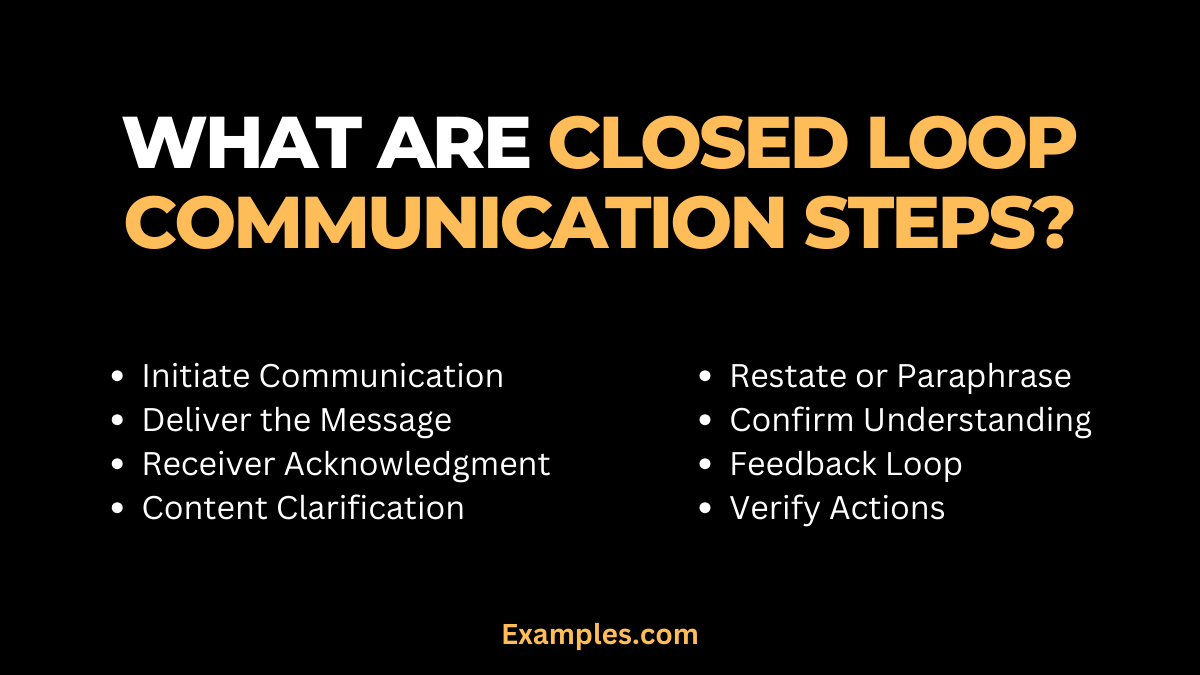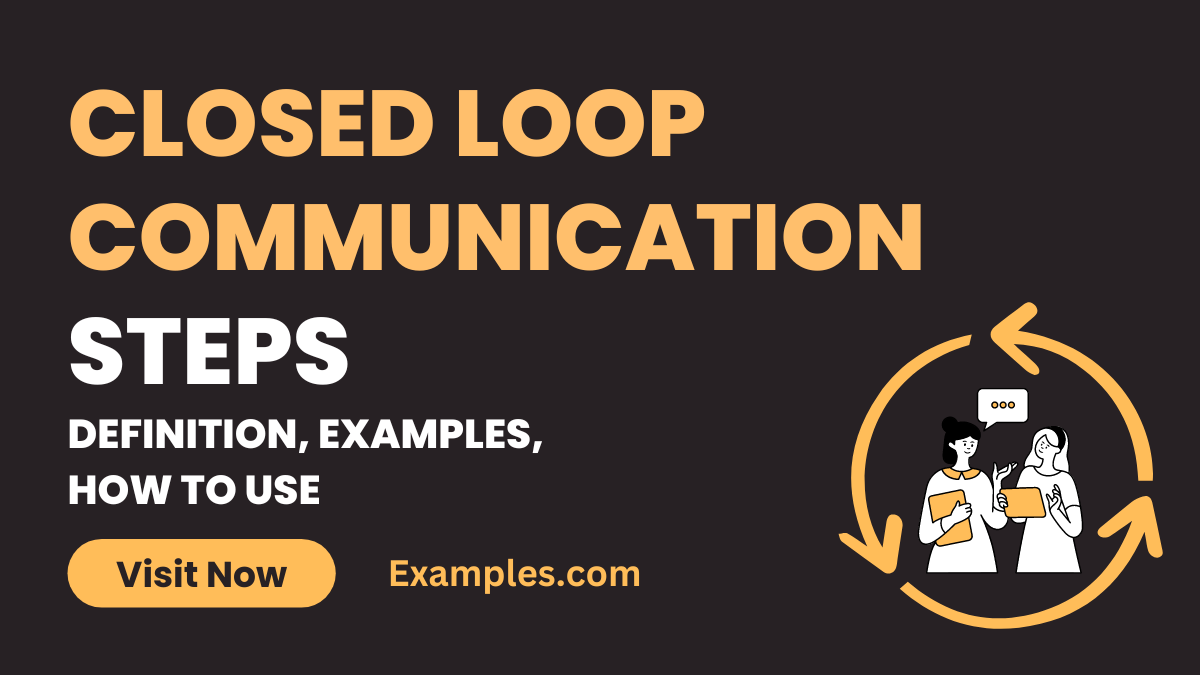19+ Closed Loop Communication Steps Examples
Discover the power of Closed Loop Communication with our comprehensive guide, enriched with practical examples. This method, pivotal in ensuring clarity and accuracy, is a game-changer in both personal and professional settings. Our guide meticulously breaks down each step, offering insights and real-life applications of Closed Loop Communication. Whether you’re a team leader, healthcare professional, or anyone aiming to enhance communication, these steps are essential tools. Dive in to explore how this technique can revolutionize your interactions, avoid misunderstandings, and foster a culture of clear and effective communication.
What are Closed Loop Communication Steps? – Meaning

Closed Loop Communication is a technique ensuring that information conveyed is understood correctly by the receiver. This method, crucial in environments like healthcare, involves a sender giving a message, the receiver repeating it back, and the sender confirming its accuracy. This cycle of communication, one of the Essential Actions for Closed Loop Communication, plays a significant role in preventing errors and ensuring effective interaction. Especially in Closed Loop Communication in Healthcare, it’s vital for patient safety and care coordination. Understanding and applying these steps is a key aspect in highlighting the Importance of Closed Loop Communication.
Download Closed Loop Communication Steps in PDF20 List of Closed Loop Communication Steps

Closed Loop Communication is a critical tool, especially in high-stakes environments like nursing. This method involves a clear, step-by-step process to ensure accurate and effective communication. By incorporating Closed Loop Communication in Nursing and Closed Feedback Loop Communication, it significantly reduces misunderstandings and errors in fast-paced situations. Here’s a list of 20 steps, with examples and explanations, demonstrating how to use Closed Loop Communication effectively:
- Initial Message Delivery: A nurse conveys instructions to a colleague. How to Use: Clearly state the message, ensuring it’s direct and to the point.
- Active Listening by Receiver: The receiving nurse attentively listens. How to Use: Focus on the speaker, avoiding interruptions or distractions.
- Message Repetition: The receiver repeats the instructions back. How to Use: Verbatim repetition ensures the message is understood as intended.
- Confirmation or Correction: The initial sender confirms the accuracy. How to Use: Affirm the message’s correctness or provide necessary corrections.
- Clarification Request: If unclear, the receiver asks for clarification. How to Use: Seek further explanation on specific points of confusion.
- Providing Clarification: The sender clarifies any misunderstood aspects. How to Use: Offer additional details or rephrase for better understanding.
- Acknowledgment of Understanding: The receiver acknowledges comprehension. How to Use: Verbally confirm understanding of the message.
- Execution of Instructions: The receiver acts on the message. How to Use: Carry out the task as instructed.
- Evaluating Results: The sender assesses the outcome. How to Use: Review if the action taken aligns with the initial instructions.
- Reinforcement of Key Points: The nurse reiterates crucial aspects. How to Use: Emphasize important instructions or steps to ensure clarity.
- Seeking Feedback: Asking for input on the communication process. How to Use: Encourage open dialogue about the effectiveness of the communication.
- Adjusting Communication Method: Modifying approach based on feedback. How to Use: Adapt communication style to better suit the receiver’s needs.
- Regular Check-ins: Maintaining ongoing communication. How to Use: Periodically check back to ensure ongoing clarity and understanding.
- Non-Verbal Cues: Using body language to reinforce messages. How to Use: Employ gestures or facial expressions to support verbal communication.
- Documentation: Recording the communication for future reference. How to Use: Write down key points to avoid future misunderstandings.
- Consistency in Messaging: Ensuring uniformity in communication. How to Use: Maintain a consistent tone and style when conveying similar messages.
- Cultural Sensitivity: Being aware of cultural differences. How to Use: Adapt communication to respect diverse backgrounds and perspectives.
- Empathy in Response: Showing understanding and compassion. How to Use: Respond to questions and concerns with empathy to build trust.
- Follow-up: Ensuring ongoing clarity and resolution. How to Use: Conduct follow-up discussions to address any lingering issues or questions.
- Feedback Post-Action: The receiver reports back after completing the task.
What is the Process of Closed Loop Communication?
Closed Loop Communication is a systematic process that ensures clear and accurate information exchange. It begins with the sender delivering a concise message. The receiver then acknowledges the message, often by repeating or paraphrasing it back. This step ensures the message is understood as intended. The sender confirms the accuracy of the receiver’s understanding, closing the communication loop. This process is particularly crucial in Closed Loop Communication in Medical settings, ensuring patient safety and effective care.
What are Closed Loop Communication Steps During Stressful Situations?
In stressful situations, the steps of Closed Loop Communication become even more critical. The process starts with delivering a clear, direct message under pressure. The receiver must actively listen, acknowledge, and repeat the message to avoid any misinterpretation. Quick and accurate confirmation by the sender is essential. Stressful scenarios, such as emergency medical situations, require Closed Loop Communication for Patients and Nurses to be swift, precise, and effective, ensuring that the right actions are taken promptly and accurately. In stressful situations, Closed Loop Communication becomes even more critical. The steps remain fundamentally the same but require more focus and precision:
- Calm and Clear Initiation: Start with a calm, clear message, especially in a Closed Loop Communication in Medical setting where stress levels can be high.
- Quick Acknowledgment: The receiver should quickly acknowledge the message to avoid delays in critical situations.
- Precise Repetition: Repeat the message accurately, ensuring no details are missed during stressful moments.
- Immediate Confirmation: The sender must promptly confirm the message to expedite actions.
- Efficient Feedback: Provide concise feedback and take swift action based on the communication.
- Regular Check-ins: Continuously check in to maintain clarity and adjust as the situation evolves.
Implementing Closed Loop Communication effectively during high-pressure scenarios can significantly reduce the risk of miscommunication and improve outcomes in critical situations.
What are the Steps for Closed Loop Communication Training in Medical Simulation?
Here are the Steps for Closed Loop Communication Training in Medical Simulation:
- Initiating Scenario-Based Training: Start with realistic medical simulation scenarios to practice Closed Loop Communication.
- Incorporating Role Play: Use role-playing exercises to simulate real-life medical situations, emphasizing the importance of clear communication.
- Feedback and Debriefing: After each simulation, provide feedback and discuss how communication could be improved.
- Reinforcing Key Concepts: Continuously reinforce the importance of clarity, acknowledgment, and confirmation in communication.
- Utilizing Technology: Incorporate medical simulation technology to create immersive training experiences.
How to Close a Loop in Communication?
- Initial Message Transmission: This step involves initiating the communication process by delivering a clear and concise message to the intended receiver. The sender should ensure that the message is straightforward and easy to understand.
- Active Acknowledgment: Once the message is delivered, it is essential for the receiver to acknowledge receipt. This acknowledgment can be verbal or non-verbal, such as a nod or a brief response indicating that they have heard and understood the message.
- Seeking Clarification: To prevent miscommunication, the receiver should be encouraged to seek clarification if any part of the message is unclear or ambiguous.
- Verification: After receiving the message, the receiver should verify their interpretation with the sender. This verification step involves restating the message in their own words or summarizing the key points to ensure accuracy.
- Documentation and Follow-Up: To maintain a record of the communication and ensure that actions are taken as discussed, it is essential to document the details of the interaction. This documentation can take the form of written notes, electronic records, or other appropriate methods.
Tips for Best Practices to Closed Loop Communication
- Consistent Practice: Consistently practicing Closed Loop Communication is crucial for honing this skill. Regularly engaging in it across different situations helps you become proficient in ensuring message accuracy and clarity.
- Cultural Competency: Cultural sensitivity is an essential aspect of Closed Loop Communication. It’s vital to be mindful of cultural differences that may affect how people interpret and respond to communication.
- Openness to Feedback: Closed Loop Communication also involves being receptive to feedback. When you engage in this communication method, you should always be open to receiving input from others.
- Technology Utilization: In today’s digital age, technology plays a significant role in communication. Utilizing technology effectively can support and enhance Closed Loop Communication. Whether it’s through email, messaging apps, video conferencing, or other digital platforms, technology can facilitate clear and timely communication.
- Comparative Analysis: Understanding the differences between Open Loop and Closed Loop Communication is essential. While Closed Loop Communication focuses on confirming understanding and ensuring message accuracy, Open Loop Communication may not include these critical verification steps.
For a comprehensive understanding of Closed Loop Communication, especially in medical and healthcare settings, it’s crucial to delve into these steps and best practices to enhance communication efficiency and effectiveness.
What is the Purpose of Closed-Loop Communication?
Closed-loop communication aims to ensure clear understanding and accuracy in message exchange, reducing miscommunication through feedback verification methods and effective communication techniques.
What is the Proper Order in doing Closed Loop Communication?
The order for Closed Loop Communication involves initiating a message, receiving and acknowledging it, followed by a readback or clarification, and then final confirmation to complete the communication cycle in healthcare.
What is the Closed-Loop Communication Method?
The Closed-Loop Communication method involves exchanging information where the sender receives explicit confirmation or clarification from the receiver, ensuring accurate information exchange and understanding.
What are the Stages of a Closed-Loop Control System?
Stages of a closed-loop control system include input communication, processing and analysis, feedback or response generation, and adjustments based on two-way communication protocols, emphasizing the importance of a communication feedback loop.
Closed-loop communication is a vital component in various sectors, particularly in healthcare, where effective communication can significantly impact patient outcomes. Studies have shown that implementing closed-loop communication can reduce medical errors. For instance, a study by the Agency for Healthcare Research and Quality (AHRQ) found that closed-loop communication techniques led to a noticeable decrease in communication errors in healthcare settings.
Moreover, according to the Joint Commission, a significant number of sentinel events are due to communication failures. Implementing closed-loop communication has been identified as a key strategy to address these failures. This approach ensures that information is correctly understood and acted upon, which is crucial in high-stakes environments like operating rooms or emergency departments.
In the field of project management, statistics from the Project Management Institute (PMI) indicate that poor communication is a major factor leading to project failure. Closed-loop communication can play a significant role in mitigating this risk by ensuring clarity and understanding among team members.
For further reading on these statistics and the importance of closed-loop communication, consider exploring resources from the Agency for Healthcare Research and Quality, The Joint Commission, and the Project Management Institute. These websites provide valuable insights and detailed statistics on the impact of communication strategies in their respective fields.



